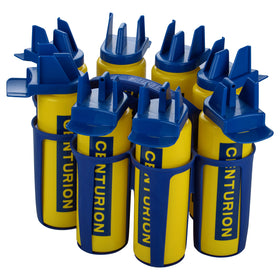Rugby Blog

The history of Bath Rugby Club
by Leana Kell
Bath Rugby club is one of the oldest and most successful rugby clubs in the UK. Since the Premier League was formed in 1986, the Club proved it was "the one to beat", winning the League 6 times in the first 8 years. Despite hitting some tougher times in 2002/3, the Club retained its fighting spirit and remains a force to be reckoned with.
Located in the World Heritage City of Bath, Somerset, Bath is part of the Aviva Premiership league and has won a host of awards over the past few decades, from the Anglo-Welsh Cup to the Heineken Cup and the European Cup Challenge. This year, Bath celebrates its 150 year anniversary, and to commemorate, Centurion takes a look below at the history behind Bath Rugby Club.
The early years
The club was founded in 1865 as Bath Football Club, and like many other rugby clubs at the time, it was formed as an offshoot of the local cricket club, who were looking for a sport to keep the members occupied during the cricket off-season.
The original rugby kit for the Bath team was blue shirts and white "knickers" with red caps that were actually worn during play by some of the XV!
In its earliest years, the club had no stable base, but it still managed to remain competitive against local and travelling teams. The Recreation Ground, famously known as The Rec, became home to the team in the late 1890s and by the 1900s, crowds of thousands were attracted to big matches
As Rugby Union became more competitive throughout the twentieth century, Bath began to take on more opponents from around the country and abroad. The club soon became known for their fast, attacking style which was unusual in Rugby Union.
The next fifty years
The Club gradually increased its fixture list and by the 1885/86 season Bath had completed 20 fixtures, winning 17, drawing 2 and losing only 1, to local teams such as Weston-Super-Mare, Gloucester, Clifton and the "Arabs" from Bristol. By the 1890s, Bath had played a number of Welsh teams, with Cardiff and Penarth regular opponents.
The financial arrangements for players at the Club at this time were far from glamorous, with players in the early part of the 20th Century expected to pay one shilling for the privilege of playing! Keen to extend its experience, the Club played its first fixture overseas in 1907 when Racing Club de Bordelais crossed the Channel to play at the Rec.
Bath continued to grow in status throughout the 1920s, and in 1925 the Club was awarded an England Trial Match.
Post-war years
Despite losing 17 players to service of the country during World War II and severe bomb damage to the Rec, the Club reformed and resumed its fixtures. In 1954, Bath took part in its first oversees tour and was highly successful, beating French teams St Claude (23-3), Givors (9-6) and Tour du Pin (17-0).
1960s, 1970s & 1980s
The reputation of the Bath team continued to grow throughout the 1960s and 1970s with many of the Bath players called up by International teams, but it was the arrival of new coach Jack Rowell that contributed to a major shake-up in the Club's style. Despite the Club still containing a host of amateur athletes, Rowell persuaded the Club to start looking further afield for players and to bring players in from outside the Bath area. This enabled him to put together a formidable side characterised by power and precision.
By the time the Premier League was created in 1986, Bath had become a force to be reckoned with, and the team went on to win the league 6 times in the first 8 years. Bath became the "side to beat" and their success in the Premier League was mirrored in a range of other national and international competitions.
From 1983 until 1996 Bath were almost unbeatable in the John Player and Pilkington Cups (the forerunners to the Tetley's Bitter Cup). During this period they failed to take home the English Cup on only three occasions, setting an amazing record of never having lost a Final or Semi-Final game in the English or, later, the European Cups.
The professional era
 In May 1996 Rugby Union became a professional sport and the transfer of players between clubs across the country became more common. But it was around this time that Bath began to struggle to maintain the achievements of the 1980s and early 1990s. Following the departure of Jack Rowell (who left to take control of the England team) , the Club struggled to find consistency either on or off the field, whilst regular changes in the coaching staff and a steady turn-around of players failed to produce the formula that led to past successes.
In May 1996 Rugby Union became a professional sport and the transfer of players between clubs across the country became more common. But it was around this time that Bath began to struggle to maintain the achievements of the 1980s and early 1990s. Following the departure of Jack Rowell (who left to take control of the England team) , the Club struggled to find consistency either on or off the field, whilst regular changes in the coaching staff and a steady turn-around of players failed to produce the formula that led to past successes.
The Club's ultimate low point was in the 2002/2003 season, when Bath narrowly avoided relegation. Following this, a change to the team tactics, coaching team and many of the squad ensured that a strong team was once again created, capable of challenging other professional squads in England.
In 2007/2008, the team went on to win the European Challenge Cup, and since then, they have remained strong contenders in competitions across the UK.
A few facts
- Bath won the English Cup Final at Twickenham an unprecedented ten times
- Bath's first international player was Herbert Fuller in 1882, although Frank D'Aguilar, first cap, 1872, subsequently became associated with the Bath club.
- Up to the time of the professional game, shirt No 13 was rarely worn in the Bath team, hence the Club full back wore shirt No 16.
- Bath's first Cup triumph at Twickenham was the 13th occasion of English Cup Competition.
- In 1998 Bath Rugby became the first British Side to win the European Cup, beating Brive 19-18 in Bordeaux. The supporters chant "Allez Bath!" was first used during this successful campaign.




